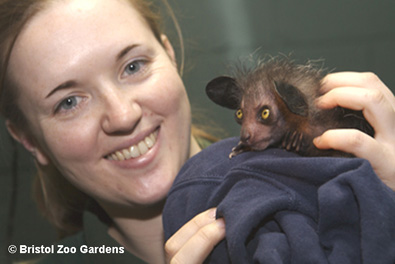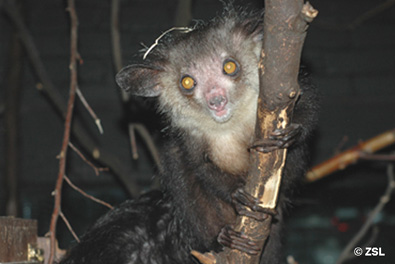The world received fantastic news last week of the recent rare birth of one of our number 16 EDGE species, the aye-aye.

The birth of this tiny and unusual creature is the latest success story of zoo based conservation breeding initiatives to help keep rare and endangered species alive. Born on November 23rd 2007 at Bristol Zoo Gardens this EDGE baby is only the second aye-aye to be hand raised in the UK.
Named “Raz” (short for Razafindranriatsimaniry which is Malagasy for “son of a Prince or noble man who envies nobody”), this tiny baby is under the constant care of a dedicated staff of four who are at hand to give this youngster two-hourly feeds round the clock. Normally babies are left to be reared by their parents however a decision was made to hand rear Raz as his mother had previously not shown success with rearing her offspring.
This is the second aye-aye success for Bristol Zoo Gardens, with their first aye-aye being born in 2005.
Long persecuted in their native home of Madagascar as an omen of death and evil, the aye-aye faces imminent extinction due to the added pressure of deforestation. The only surviving members of the Daubentoniidae family, aye-ayes are rarely seen in zoological parks. Worldwide the captive population of the aye-aye (Daubentonia madagascariensis) stands at 40 (18 males and 22 females). Aye-ayes exhibit a number of unique morphological traits that set them apart from other primates and enable them to exploit resources unavailable to most other animals in Madagascar.
Read more about their amazing adaptations here.
Aye-ayes are endemic to Madagascar, where populations are believed to be declining. They have specific Convention on International Trade in Endangered Species of Wild Flora and Fauna (CITES) designation (CITES, Appendix I) due to their restricted habitat.
Historically, aye-ayes have shown poor reproductive records in captivity, and as a species whose future hangs in the balance (the aye-aye is listed as Endangered on the IUCN Red List), births like these are great news for aye-aye conservation worldwide.
However, whilst the captive breeding of endangered animals plays an important role in their preservation by raising awareness and providing an “insurance” against extinction in the wild, conservation of species in their natural habitats is crucial. The aye-aye exists in various parks in Madagascar, yet law enforcement of these areas is often lacking. Increased protection and conservation awareness programmes targeting habitat protection and the dispelling of negative myths associated with this species are crucial to ensure current wild populations remain stable. In addition, further surveys of existing populations and a programme to compensate farmers for damage to crops caused by aye-ayes may also be beneficial.
Fossil records show that an extinct robust form of the aye-aye (Daubentonia robusta) once existed in the dry southwest of Madagascar, which is the only area where the todays’ aye-aye currently does not exist. Daubentonia robusta is predicted to have weighed up to five times that of the existing aye-ayes and some evidence shows that this extinct species co-existed with humans. Drilled incisors of this species have been found seemingly for use as pendants. Evidence is yet to confirm whether anthropogenic forces contributed to the extinction of this species
ZSL London Zoo is also home to two aye-ayes; female Mamy and male Tany. They are housed in a special nocturnal house and share their enclosures with another EDGE species, the Endangered Malagasy giant jumping rat.
It is hoped that ZSL London Zoo will have similar success with their breeding pair. Click here to read more information about the aye-aye.

